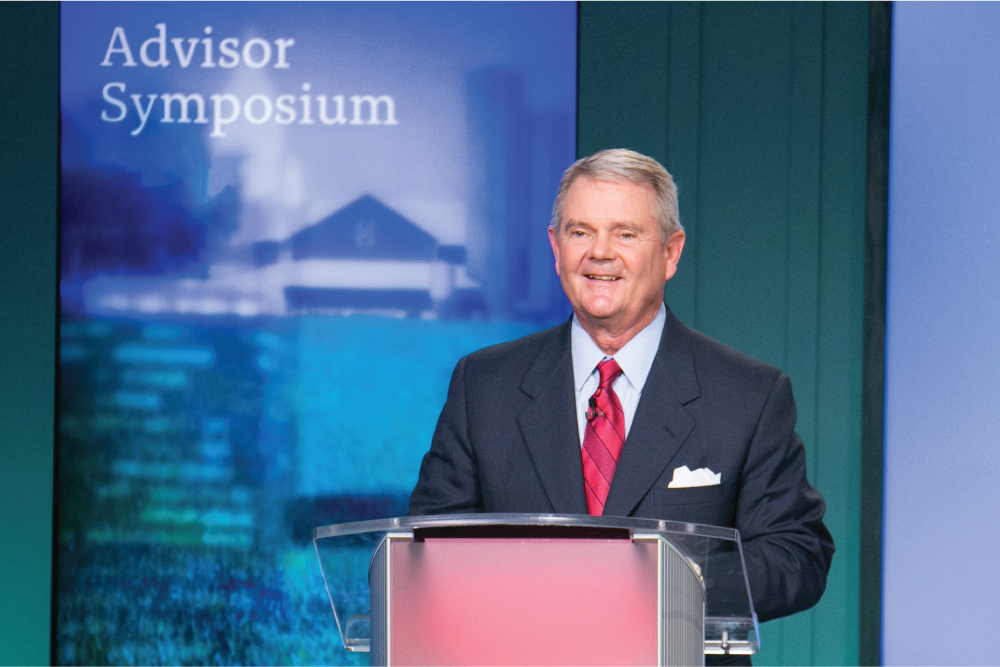A Systematic Approach to Integrating Financials
Today, from small companies to major corporations, the number of employees who specialize in business process management, or BPM, has grown exponentially in the past three decades.
Well ahead of that trend was Michael R. Noland, CLU®, ChFC®, AEP®, founder and president of Integrated Financial, an M.R. Noland company. He is so much about the process that he trademarked an approach to wealth management known as The Integrated Planning Process™.
“What we’re known for in our community is being very process-oriented and goals-based,” Noland told Advisors Magazine in a recent interview.
During his college years at the University of Tulsa, Noland worked as an assistant at a large public golf course and ultimately became the head assistant. He made decisions on staffing, work schedules, merchandising, financial management and more. To this day, he describes the experience as the best MBA program he could have ever taken. “I knew I wanted to be in business for myself, and after being introduced to a person in the personal financial services business, I realized I liked the idea of helping individuals make wise decisions regarding their financial matters,” Noland recalled. “One thing that appealed to me about the financial services industry is that it did not require hundreds of thousands of dollars of capital to open your door.”
“I knew I wanted to be in business for myself, and after being introduced to a person in the personal financial services business, I realized I liked the idea of helping individuals make wise decisions regarding their financial matters,” Noland recalled. “One thing that appealed to me about the financial services industry is that it did not require hundreds of thousands of dollars of capital to open your door.”
Noland steadily built his practice, headquartered in Tulsa, and after more than four decades in business, it now serves clients in 33 states.
About 10 years into the practice, Noland noticed that people were mainly doing what he calls silo planning.
“They’d go to an attorney or maybe an accountant or their investment person or an insurance professional and they would get some very good recommendations, but all seen through that person’s professional lenses,” Noland said. “And the recommendations were not really integrated around the client’s goals and objectives.”
The recommendations were not integrated because not one of the professionals took the time to do a deep dive into a client’s goals for themselves, their families, their business or possibly any philanthropic endeavor.
“No one would really ask the right questions and listen objectively, and then ask the next question, and then the next and put those goals and objectives into a written family financial objective philosophy,” Noland explained. “I have found that once there is clarity on goals and objectives, the recommendations are much more on point and the client is more likely to take action.”
Process-oriented and methodical
And that’s what led Noland to develop the core idea behind his business of Integrated Financial – pulling everything together in a highly methodical manner by first obtaining clarity on one’s financial goals and objectives.
His Integrated Planning Process uses a four-step, personal, values-driven process to assist clients in developing a wealth management strategy consistent with their mission, vision, values, and goals. The ultimate objective is to optimize the use and deployment of financial, human and intellectual capital consistent with each client’s core values.
“I like to say to clients that there’s economics to planning and psycho-nomics to planning,” Noland explained, “because any plan has to feel right to them.”
Discovery is the first step in the process, in which Noland and his team garner the necessary insights making sure there’s clarity on goals and objectives. The specific purpose of this first step is fivefold:
• To crystallize planning objectives by documenting and verifying core goals and values.
• Define financial independence, family legacy, and social capital goals.
• Analyze current financial position, planning documents, and life insurance.
• Identify an ideal plan objectives checklist.
• Produce a GAP analysis and identify inconsistencies and opportunities.
At this initial step, the client can expect to attain clarity related to their ideal plan, which addresses what and why, not how. Criteria is established for a client’s advisory team, potential results are explained, and a written vision statement is prepared for the client, which provides critical insight and perspective to their advisory team.
“This is all played back to the client, and once we have agreement on that, then we can drop down to solutions,” Noland said.
Solutions modeling is the second step. Its purpose is to explore potential solutions consistent with the client’s vision, values, and goals. Economic models are provided, as well as education about strategies and tactics to help clients achieve desired results. Noland mentions that clients can expect all solutions to be consistent with the established planning benchmark for their ideal plan, as established in step one.
Clients can also expect the solutions step, heavy on explanation and education, to empower them with knowledge to help make educated decisions on what strategies, variations, and combinations they may wish to pursue. Another expectation of step two: the client’s advisory team begins to take shape.
Implementation is the third step. Here, the client’s advisory team executes the solutions that allow the ideal plan vision to become a reality. Appropriate vendors for financial products and fiduciary roles are selected. A client can begin to expect actual results that are consistent with the established planning benchmark set in step one.
“Often, during implementation, we find that things have fallen through the cracks,” Noland remarked. “Documents aren’t in place, trusts aren’t funded, beneficiaries aren’t designated or corrected on accounts. So, this step is about taking responsibility and executing properly. Plans on paper are meaningless unless they are implemented.” Maintenance is the fourth part of the process cycle. Noland likes to say, “a great plan will become only average if not maintained.”
Maintenance is the fourth part of the process cycle. Noland likes to say, “a great plan will become only average if not maintained.”
And this is the stage where the ideal plan becomes the master plan with everything all in one place, ready to be reviewed and revisited. One portfolio is assembled as an integrated and multi-disciplinary summary of a client’s wealth management planning. It collates copies of planning documents, financial data, life insurance information, along with advisory team contact details.
Comprehensive and clear, the master plan also provides peace of mind to clients. They are secure in the knowledge, according to Noland, that their heirs and advisory team have that master plan to assist them during the transition period, following death.
During the maintenance phase, regular meetings take place with clients to determine if any plan changes are necessary.
“So, we effectively find ourselves back at the discovery step to see if any modifications are required, and then it’s finding the solutions, implementing and maintaining – the process cycle begins once again,” Noland said.
While Noland and the team at Integrated Financial are sticklers for the process and its uniformity, the results always turn out highly customized for clients.
“From a distance, all snowflakes look alike, don’t they? But when you examine them up close, they’re all unique and different,” Noland offered as an analogy. “Their crystalline structures are all different and that’s how we approach each client. By starting at the same spot with everyone – discovery – to make sure we have clarity on goals and objectives, it allows us to craft a unique plan around their individual circumstances.”
Integrated Financial does have a firm minimum, according to Noland, which is based on income, assets, and other complexities. For example, a business owner would have different circumstances than an individual and therefore more comprehensive planning needs.
In fact, in addition to trademarking Integrated Planning Process™, Noland also uses his strategic partner, The Nautilus Group®, they offer a defined planning process for business owners called Life Plan for Your Business® which is a proprietary collection of tools and resources specifically for business owners.
The Life Plan strategy focuses on business planning by carefully examining short- and long-term goals. The process is paramount here also. A series of six steps help business owners create a succession plan that meets their objectives and individual situations.
For more information on Integrated Financial, visit: nolandcompanies.com
Michael R. Noland is a Registered Representative offering securities through NYLIFE Securities LLC (member FINRA/SIPC) A Licensed Insurance Agency, 15 W 6th Street Tulsa, OK 74119, (918) 592-5885. Michael R. Noland, Member Agent, The Nautilus Group®, a service of New York Life Insurance Company. Integrated Financial is not owned or operated by NYLIFE Securities LLC or its affiliates. Michael R. Noland is a Financial Adviser offering investment advisory services through Eagle Strategies LLC, a Registered Investment Adviser.





